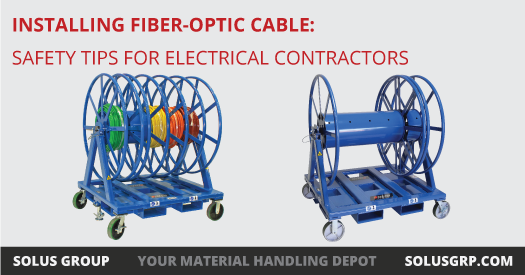We use cookies to make your experience better. To comply with the new e-Privacy directive, we need to ask for your consent to set the cookies. Learn more.
Installing Fiber-Optic Cable: Safety Tips for Electrical Contractors
Many electrical contractors are expanding their businesses by installing fiber-optic cable as a whole new business segment. With a firm grasp of the principles of traditional cable pulling and electrical installation, electricians shouldn't have too much trouble adapting to the idiosyncrasies of wiring for communications.
Despite the similarities, though, fiber-optic cable is a whole different technology. It comes with risks all its own. Here are some tips that can help electrical contractors stay safe as they approach the world of installing fiber-optic cable.
-
Wear your safety glasses.
The main issue surrounding fiber-optic cable is that the glass or plastic wires that carry light can be very, very sharp when exposed.
They also have a tendency to break off and blow around through the air. That's why you should always wear safety glasses on any work site that uses fiber-optics. Choose the kind that come with integrated side shields.
-
Wash your hands carefully after working with fiber-optic cable.
As mentioned, shards of fiber optic cable can end up anywhere. That includes your hands, and if you go have a burger fresh from the job, you might end up consuming a bit of wire, which can lead to internal hemorrhaging.

-
Never eat or drink near the installation site.
Fiber-optic splinters are essentially glass splinters. You definitely don't want to get those inside your body. Experts warn installers to keep food and drink far away from fiber-optic cable.
-
Keep fiber-optic cable safely stored on dedicated payout reels.
Because so many of the dangers of fiber-optic materials comes from its splinters, it is essential to protect your cable during storage and payout.
A Parallel Reel Payout (PRP) from Solus Group makes this task simple. Its heavy-duty steel frame will keep product safe, while a smooth powder coating prevents wear and tear during payout.
Choose between various combinations of free-spinning wheels. You can load up a PRP at the warehouse and haul it to the worksite; it's a portable storage solution for electrical and fiber-optic cables.
In addition to these tips, remember that fiber optics work by translating electrical signals into light pulses; it's designed to carry light. That means you must be sure there isn't a light source at the other end of a length of fiber-optic cable before staring directly into it.
The Fiber Optic Association, a trade group, recommends testing open cable with a power meter before looking into the end. Hold exposed wiring at an angle to your face, and be sure to keep it at least 6 inches away from your eyes.
By following these safety tips, you'll be able to add installing fiber-optics to your list of services—without any risk to you or your employees.
References:
Herres, David. "Working with Fiber-Optic Cable." ECMWeb. Penton, 18 Dec. 2017. Web. 15 Aug. 2017.
"Safety in Fiber Optic Installations." TheFOA. The Fiber Optic Association, n.d. Web. 15 Aug. 2017.
"Safety Rules for Fiber Optics." TheFOA. The Fiber Optic Association, n.d. PDF. 15 Aug. 2017.
